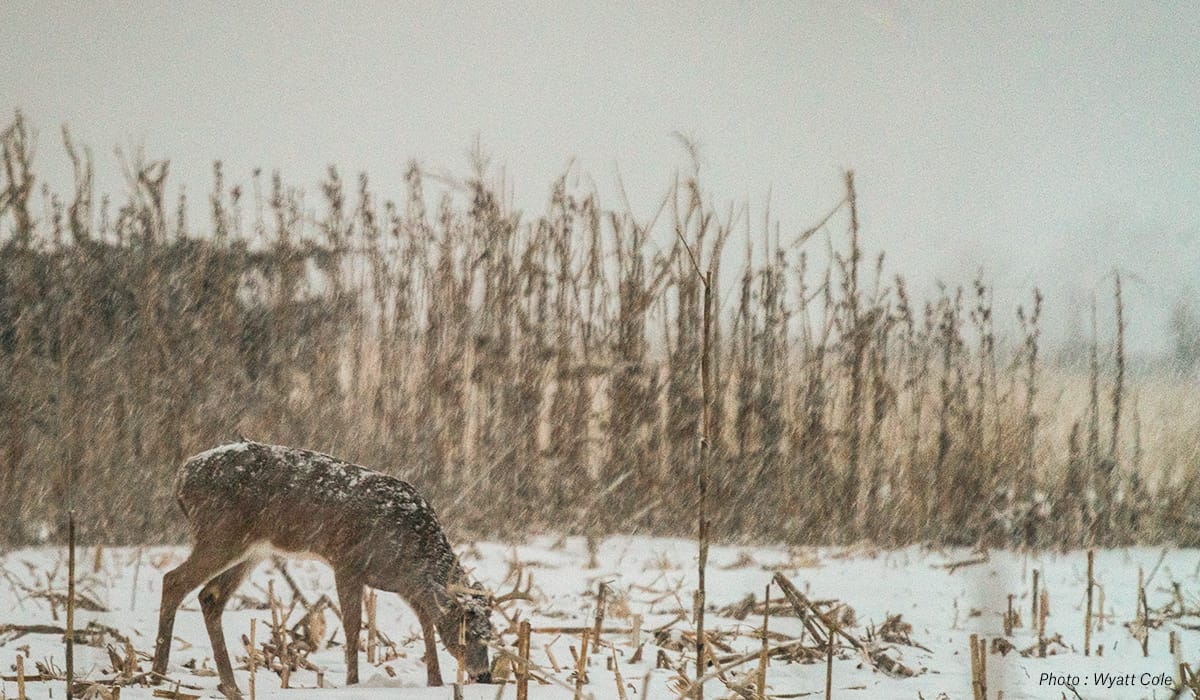In the U.S. we find whitetail deer from southern Florida all the way to the southern tip of Alaska, but not all deer face harsh winters, and freak storms in relatively warm climates won’t necessarily kill herds of whitetails. Whitetails are resilient. So what does cause winter kill and what keeps deer from dying off in winter? We explore many of the factors that help deer through winter with North Carolina Wildlife Resources Commission Deer Biologist Moriah Boggess. He helps us sift through fact and myth.
About Winter Die-Offs
Winter kill happens when harsh weather disrupts a deer’s access to food, kills off some of its food sources, and/or there is a lack of respite from the elements. Deer that die off from exposure are ones that were likely severely malnourished or otherwise diseased and they lacked the energy stores to keep them warm and healthy.
Furthermore, when we talk about winter die-off, we are really talking about the risk to whitetails in the more northern band of their range.
“Across the Southeast and most of the Midwest the winter stress period does not pose a risk for winter die-offs,” says Boggess. “Winter mortality events can take place in the northern extent of the whitetail’s range and in these regions are more common in nutritionally stressed herds.”
This stresses an important fact about winter die-off, and that is when it happens it’s usually not killing off the biggest and best bucks or the most healthy, prolific does.
“Winter mortalities often occur in individuals with underlying health issues, such as those fighting infections, injuries, or high parasite loads,” says Boggess. “In these circumstances, winter mortality events can weed out some of the weaker individuals in a population that may otherwise die.”
From a management (and hunting) perspective, winter kill isn’t necessarily a bad thing for the overall whitetail population. But constant winter pressures on herds can take their toll over time.
In Wisconsin and the Upper Midwest, a Winter Severity Index (WSI) has been in use for over five decades. It’s a way to measure how severe the winters are that also quantifies the impact it has on deer populations.
It works by assigning one point for a region for each day the low temperature reaches below zero (not including wind chill). It assigns another one point for each day that has an average snowpack level of 18 inches or greater. A winter with a WSI total of fewer than 50 points is considered mild; 50 to 79 is moderate; 80 to 99 is severe, and over 100 is very severe. With the WSI, wildlife scientists can more easily and accurately determine the weather’s impact on herd survivability and spring fawning success.

Winter Habitat Essentials
“Ultimately, it’s the availability of good winter food that determines whether the stresses from extreme cold and snow events will overcome animals and lead to mortalities,” says Boggess.
For deer to survive winter they need access to nutritious food and protection from the elements. There’s a joke that deer love to eat people’s gardens; in fact, they’ll even eat a rock garden. While that’s not entirely accurate, deer are known to eat a very wide variety of foods (over 400 different plants in the South alone). But when winter comes, deer eat differently.
“Whitetail winter diets often differ from other times of the year as they switch to consuming more woody stems, twig ends, and buds (commonly referred to as woody browse),” says Boggess. “Deer are well adapted to eating woody browse but will readily supplement their diet with foods like red oak acorns, cool-season forbs, waste grain, and food plots when available.”
“In the Southeast, there are numerous waxy-leaved species that keep their leaves through much of the winter,” says Boggess. “For instance, giant rhododendron, Chinese privet, Japanese honeysuckle, inkberry, and blueberries are all species whose leaves are commonly consumed by deer through winter.”
But the food only goes so far. They need protection too. It’s true that deer, with their thick undercoat and hollow guard hairs, can survive temperatures as low as 30 degrees below zero, but they can, like humans, also succumb to hypothermia. In short, deer need thermal cover.
“Thermal cover is important for deer in winter because it helps deer conserve energy, thereby reducing winter stress,” says Boggess. “Good thermal cover has ample cover at ground level to block the wind but has an open canopy to let sunlight in for its warmth.”
What makes for good thermal cover? According to Mossy Oak, “Conifer trees like cedar, red and white pine, spruce and hemlock provide excellent thermal cover because the dark green foliage absorbs the heat from the sun. Red oak trees, because they hold their brown leaves through winter, can also offer this thermal effect.”
Habitat Tips
Are the whitetails in your area prone to winter die-off? If you have land to manage and want to create a better habitat for them over winter, here are some tips. But remember, managing a deer population below carrying capacity is as much, or even more, important as a good habitat management strategy. Bringing too many deer in will do more harm than good because they will be stressed, run out of food, and be highly susceptible to winter kill.
“The key to great quality deer habitat is having a variety of food and cover options available for all seasons of the year,” says Boggess. “When it comes to habitat for winter, food should be priority with thermal cover following after. A holistic habitat management plan should include much more than supplemental food plots. Strategic forest and old field management should be implemented to annually disturb plant communities, providing multiple stages of plant succession across the property.”
What deer need are stable food sources that vary, both in terms of types of food and stages of growth, and they need areas to be safe and warm. They also need enough space for however many deer will leverage the habitat.